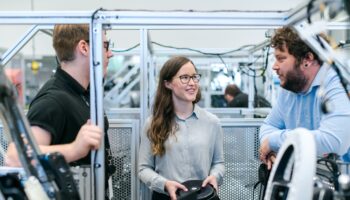Introduction
The automotive industry is undergoing a transformative shift, driven by rapid advancements in technology, changing consumer preferences, and global environmental concerns. As we look ahead to the year 2030, the automotive forecast offers a glimpse of what the industry might look like in the next decade. This article presents an in-depth analysis of key trends, challenges, and opportunities that will shape the automotive Industry’s Future in 2030.
- Electric Vehicles (EVs) Take Center Stage
By 2030, electric vehicles are expected to dominate the automotive market. The push towards sustainability and government initiatives to reduce carbon emissions have accelerated the adoption of EVs. Major automakers, including traditional giants and new entrants, are heavily investing in EV development to meet consumer demand for cleaner and greener automotive Industry’s Future in 2030.
With significant advancements in battery technology, EVs’ range and charging capabilities will improve, eradicating “range anxiety” and making them more appealing to the masses. Additionally, the declining costs of batteries will drive down the overall cost of EVs, making them more affordable and accessible.
- Autonomous Vehicles (AVs) Transforming Mobility
The rise of autonomous driving technology will redefine the concept of personal mobility. By 2030, autonomous vehicles are expected to become mainstream, especially in ride-hailing and shared mobility services. These vehicles will leverage advanced sensors, artificial intelligence, and connectivity to navigate roads safely and efficiently.
AVs have the potential to reduce accidents and traffic congestion significantly, making roads safer and more efficient. Furthermore, they will enhance mobility options for elderly and disabled individuals, providing them with newfound independence and freedom.
- Mobility-as-a-Service (MaaS) Revolutionizes Transportation
2030 will witness the flourishing of Mobility-as-a-Service platforms, where consumers can access various transportation options through a single digital platform. MaaS will integrate public transit, ride-hailing, car-sharing, micro-mobility services, and even AVs into a seamless, interconnected system.
Consumers will have the flexibility to choose the most suitable and cost-effective transportation mode for each journey, reducing the need for individual car ownership. This shift towards shared and on-demand mobility will lead to a decrease in the number of private vehicles on the road, resulting in reduced traffic congestion and lower carbon emissions.
- Connectivity and 5G Enable Smart Vehicles
The proliferation of 5G technology will revolutionize vehicle connectivity, enabling a new era of smart vehicles. By 2030, most new cars will be equipped with advanced connectivity features, allowing real-time data exchange between vehicles, infrastructure, and the cloud.
Smart vehicles will facilitate Vehicle-to-Everything (V2X) communication, improving road safety, traffic management, and overall efficiency. Additionally, over-the-air updates will become standard, allowing automakers to deliver software updates and new features seamlessly.
- Sustainability and Circular Economy
By 2030, automotive manufacturers will be increasingly focused on sustainability and the circular economy. EV batteries will be recycled, and manufacturers will incorporate more recycled materials in vehicle production, reducing their environmental footprint.
Furthermore, the concept of “cradle-to-grave” product lifecycle management will gain traction, promoting responsible end-of-life vehicle disposal and recycling practices.
- Shift in Automotive Ownership and Business Models
The rise of MaaS and shared mobility services will lead to a shift in automotive ownership patterns. Traditional individual car ownership will decline as consumers embrace alternative modes of transportation. Ride-hailing and car-sharing services will offer flexible and cost-effective alternatives, especially in urban areas.
Automakers will adapt their business models, focusing on service-oriented offerings rather than just selling vehicles. They will partner with technology companies and mobility service providers to provide comprehensive transportation solutions to customers.
- Regional Variations in Adoption
The pace of automotive transformation will vary across regions due to differences in infrastructure, regulations, and consumer preferences. Developed economies with robust EV charging infrastructure and supportive policies will lead the transition towards electric and autonomous vehicles.
On the other hand, emerging economies may experience a more gradual shift, with internal combustion engines continuing to dominate the market, albeit with improving emission standards.
- Digitalization and Customer Experience
The automotive industry’s future will be defined by digitalization and customer-centric experiences. Automakers will invest in enhancing in-car digital interfaces, offering personalized services, and improving user experiences.
Digital showrooms and online vehicle sales will become the norm, streamlining the car-buying process. Augmented reality and virtual reality technologies will allow customers to explore and customize vehicles in immersive virtual environments.
- Cybersecurity and Data Privacy
As vehicles become more connected and reliant on digital technologies, cybersecurity and data privacy will emerge as critical concerns. Automakers and technology providers will need to invest heavily in securing vehicles against cyber threats and safeguarding user data.
Government regulations will play a crucial role in ensuring cybersecurity standards are met, safeguarding consumers’ trust in autonomous and connected vehicles.
- Reshaping the Automotive Workforce
The automotive industry’s transformation will have a significant impact on the workforce. The demand for software engineers, data scientists, and AI specialists will rise to develop and maintain the sophisticated technology in vehicles.
Traditional automotive jobs may shift towards higher-skilled positions, while retraining programs and upskilling initiatives will be essential to bridge the skills gap and ensure a smooth workforce transition.
Conclusion
The automotive forecast for 2030 presents a dynamic and innovative industry characterized by electric vehicles, autonomous technology, smart connectivity, and shared mobility. As the world moves towards a more sustainable and technologically advanced future, automotive manufacturers, policymakers, and consumers must collaborate to embrace the opportunities and address the challenges of this transformative era.
The transition to electric, autonomous, and connected vehicles will revolutionize personal mobility, reshape transportation systems, and contribute to a more sustainable and environmentally conscious world. By proactively adapting to these changes, the automotive industry can pave the way for a brighter and more efficient future of transportation.
- THE EVOLUTION OF PLASTIC SURGERY - 17 June 2024
- CHOOSE THE RIGHT PERSONAL INJURY LAW FIRM IN CHARLOTTE NORTH CAROLINA - 16 June 2024
- Email UX optimization, offering actionable insights - 16 June 2024






1 Comment